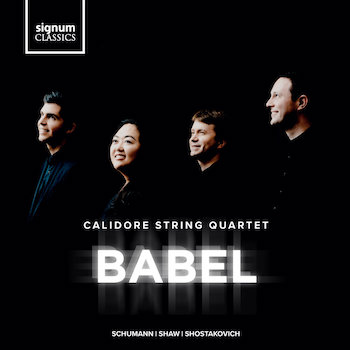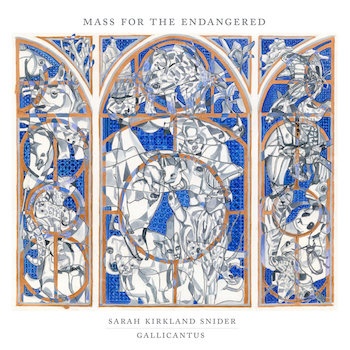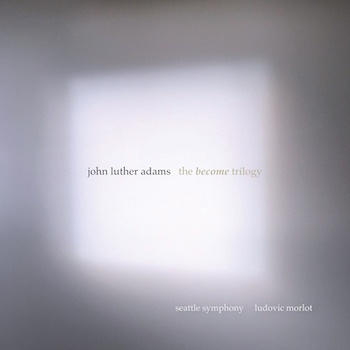Classical CD Reviews: “Babel,” Sarah Kirkland Snider’s “Mass for the Endangered,” and John Luther Adams’ “Become Trilogy”
By Jonathan Blumhofer
Calidore String Quartet’s Babel is one of the year’s best albums; Sarah Kirkland Snider’s Mass for the Endangered offers an unsettling and beautifully direct rethinking of the traditional Roman liturgy; for John Luther Adams fans – and the Adams-curious – Become Trilogy is a must.
 Certainly there’s something admirable about the concept behind the Calidore String Quartet’s (CSQ) new album, Babel. Its focus is, as the liner notes put it, “the innate human drive for communication,” represented, in this case, by Robert Schumann’s String Quartet no. 3 (a birthday present for his wife, Clara), Dmitri Shostakovich’s String Quartet no. 9 (a subversive 1964 essay written as a kind of response to political censorship), and Caroline Shaw’s Three Essays (each of which take historical or contemporary totems as departure points for musical meditations).
Certainly there’s something admirable about the concept behind the Calidore String Quartet’s (CSQ) new album, Babel. Its focus is, as the liner notes put it, “the innate human drive for communication,” represented, in this case, by Robert Schumann’s String Quartet no. 3 (a birthday present for his wife, Clara), Dmitri Shostakovich’s String Quartet no. 9 (a subversive 1964 essay written as a kind of response to political censorship), and Caroline Shaw’s Three Essays (each of which take historical or contemporary totems as departure points for musical meditations).
Finer – and more memorable – though, are the performances.
The CSQ’s Schumann Third is spirited and demonstrates just what a terrific ensemble this ten-year-old group is. Balances, intonation, uniformity of lines, richness of tone is all exquisitely done. What’s more, they’ve got a great expressive handle on the music, be that the first movement’s floating lyricism; the second’s shapely rhythms and vigorous contrapuntal episodes; the ardent, impressively-focused third; or the gamboling finale, with its leaping triplet figures.
Throughout, the score’s passionate climaxes are robust, its nervous sections shimmer, and there’s never a lack of daring (either in the CSQ’s playing or their reading’s larger sense of discovery).
A similar focus pervades their Shostakovich Ninth that closes the album. Indeed, this is at times a furiously taut performance, especially in the third and fifth movements (the latter’s coda is downright savage). But it’s not all grim: the first movement is flexibly phrased and carefully balanced, while the second is warm and impassioned.
Throughout, the CSQ make impressively light work of Shostakovich’s packed writing: this is music of incredibly tight motivic uniformity – one can easily get lost in its thickets. It’s not just that the CSQ doesn’t, but, more, that they bring the transformations of all these thematic ideas across so naturally and clearly (not to mention with such intensity) that raises this interpretation to a very high level.
Between these standards comes Shaw’s Three Essays. The first, “Nimrod,” takes the biblical Tower of Babel as its motivation; the second, “Echo,” draws on social media; the last, “Ruby,” combines thematic elements of the first two in a kind of tribute to a 1990s programming language.
It’s an agreeable piece, very well-written for the ensemble, and dispatched here with brio. There’s a lovely mix of musics going on in “Nimrod” – pulsing patterns, fragments of tunes, folk-like gestures, scales, and whatnot – while “Echo” features extended techniques (scratch tones developing into pitch) framing some beguiling ideas in the middle (the sequence of natural harmonics around the movement’s midpoint works extremely well).
Rounding it out is “Ruby,” which starts with an ear-catching series of glissandos from one chord to another before building to a convincing summation of the previous movements’ statements.
Taken together, it’s one of the year’s best albums. When live musical performances return in a few month, the CSQ shouldn’t be missed. Until then, at least we have this superb release.
 Sarah Kirkland Snider’s Mass for the Endangered offers a rethinking of the traditional Roman liturgy, moving away from the relationship between God and Man to instead focus on Nature, the environment, and endangered creatures and habitats. Sung here by the British choir Gallicantus, it proves a striking piece, at once unsettling and beautifully direct.
Sarah Kirkland Snider’s Mass for the Endangered offers a rethinking of the traditional Roman liturgy, moving away from the relationship between God and Man to instead focus on Nature, the environment, and endangered creatures and habitats. Sung here by the British choir Gallicantus, it proves a striking piece, at once unsettling and beautifully direct.
The Mass’s six movements intermix the traditional liturgical texts with new poems by Nathaniel Bellows that serve as tropes on the familiar proceedings. Conceptually, it’s not a new idea, though, on the main, it’s handled subtly here; the concluding “Agnus Dei,” for instance, with its juxtaposition of a vision of a suffering creation and suffering creator, is particularly affecting.
Throughout, Snider’s writing is essentially lyrical and diatonic, though colored by pungent dissonances. Her text setting is always clear – the Mass’s texts always speak – and marked by striking instrumental gestures (the “Gloria’s” beautiful, delicate harp writing, for one, stands out).
True, the latter quality compensates for some stasis of tempos and textures but, in general, Snider’s idiomatic handling of the voices, her way with the melodic line, and sense of when to employ ear-catching harmonic turns carries the day.
To be sure, one could hardly ask for a purer, more focused performance than Gallicantus turns in. The group’s intonation and diction are spot-on; solos are beautifully blended with the (slightly) larger ensemble; and the instrumental accompaniments (led by Sally Pryce’s exquisite harp playing) deftly done. In all, a touching and haunting effort – not to mention a timely one.
 One of the singular accomplishments of Ludovic Morlot’s tenure with the Seattle Symphony were the pair of John Luther Adams premieres he oversaw: Become Ocean (in 2013) and Become Desert (in 2018). Now, those two scores are joined by Become River, Adams’s 2010 St. Paul Chamber Orchestra commission, in a new recording from the Symphony to form the Become Trilogy.
One of the singular accomplishments of Ludovic Morlot’s tenure with the Seattle Symphony were the pair of John Luther Adams premieres he oversaw: Become Ocean (in 2013) and Become Desert (in 2018). Now, those two scores are joined by Become River, Adams’s 2010 St. Paul Chamber Orchestra commission, in a new recording from the Symphony to form the Become Trilogy.
Taken together, the three pieces certainly share some resemblances.
Become River grows and deepens from spare, ethereal natural harmonic string arpeggios at the beginning to a rich, dense, delta-like conclusion. There’s a lot to take in in Adams’s writing, particularly as regards rhythm, color, and space. While the latter doesn’t come across as strongly on disc as it likely does in a concert hall, the remainder does – as does the Ives-ian quality of Adams’s conception (though his writing remains, broadly speaking, more diatonic in River than dissonant).
Become Ocean also revolves around repeating musical processes unfolding in a broad space, though these are generally more menacing and churning than those found in River. Here, too, Adams’s writing is generally more dissonant and denser, though there are luminous moments (particularly for marimba and harp) and episodes of repose.
Become Desert, on the other hand, utilizes a process of rhythmic, harmonic, and tonal accretion that, once a critical mass is reached, slowly dissipates (put another way: the piece starts in the stratosphere, gradually descends to the lower reaches of the orchestra, and then goes back up). As in Ocean, there’s no hurry to the unfolding of processes here; rather, there’s a sense of space that’s almost mirage-like: sounds rise up, vanish, reappear in the same (or slightly varied) guise from elsewhere in the massed ensemble.
In all three works, there’s a bracing sense of structure that Morlot and his orchestra elucidate quite wonderfully. There’s also a captivating elemental sweep and play of sonority at work, especially in Become Desert (which is the only piece of the triptych to employ chorus). While the trilogy is probably best experienced live (especially for their spatial elements, which don’t really come across here), these performances are tightly played and brimming with color.
What this music requires most is patience: running forty minutes each, Become Ocean and Become Desert offer next-to-nothing by way of development of materials. Rather, they invite one to experience sonority for sonority’s sake. That might not be to all tastes. But, for Adams fans – and the Adams-curious – this Become Trilogy is a must.
Jonathan Blumhofer is a composer and violist who has been active in the greater Boston area since 2004. His music has received numerous awards and been performed by various ensembles, including the American Composers Orchestra, Kiev Philharmonic, Camerata Chicago, Xanthos Ensemble, and Juventas New Music Group. Since receiving his doctorate from Boston University in 2010, Jon has taught at Clark University, Worcester Polytechnic Institute, and online for the University of Phoenix, in addition to writing music criticism for the Worcester Telegram & Gazette.
